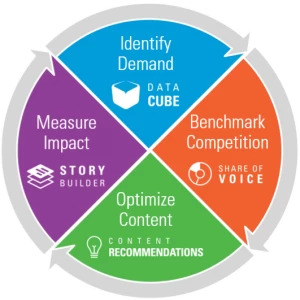SEO management means integrating different parts of SEO best practices to accomplish your online goals, including driving more leads, increasing your brand exposure and growing your share of traffic. With more than 51% of traffic coming from organic search, doing SEO effectively becomes increasingly important. Search algorithm enhancements have driven the growing complexity of SEO optimization. Increasing competition is pushing many companies to create more content and to make it better quality, more engaging, and mobile optimized. All these factors make SEO efforts sophisticated and require a clear framework and an appropriate technology. With 8 years of close cooperation with such top SEO performing brands as Microsoft, Twitter, Facebook, Home Depot, Deloitte, 3M, and many others we developed a solid 4-step methodology for efficient SEO management. Our BrightEdge platform helps to make each of these 4 steps faster and easier – saving time on analysis, measurement, and reporting. This frees you to concentrate on content creation and bringing more value to your customers. The platform covers the entire SEO cycle – from context-based goal setting and understanding the audience to optimizing the workflow.
SEO management in 4 steps
- Identify demand
- Benchmark competition
- Optimize content
- Measure Impact
Identify demand
Targeting demand means learning which topics interest your audience and uncovering the queries your customers use to look for your product or service. First, you want to understand which topics your website already ranks for and what keywords are already driving good traffic. Make sure to preserve and defend those results in the first step of SEO management. Second, do keyword research to find new topics to expand your reach and new traffic or further engage your intended audience. The research and analysis involved in targeting demand makes it one of the most complex stages in the SEO cycle. Competitive pressure pushes companies to create more content and target more keywords. Marketers usually require multiple tools to get the necessary information and insights. High-quality targeting consumes a considerable amount of time. Even with free or inexpensive tools, marketers must find the hours needed to track down the information. That is why scalability remains a major SEO management challenge – doing a due diligence this way on 100s of keywords is possible, but it can hardly be done for 1000s of keywords. BrightEdge’s SEO management platform solves the scalability issue. The BrightEdge Data Cube is a unique, patented technology that makes targeting demand straightforward and drastically improves the efficiency and effectiveness of the research process. Data Cube is a resource in BrightEdge's SEO management platform that allows you to perform research both by domain and by keyword. On the keyword level, it suggests other potential keywords and allows you to track them with a click of a button. This feature will often identify relevant ideas and topics that you had not previously considered for SEO management. The Data Cube also segments its suggestions into High-Ranking Keywords, Long-Tail keywords and Universal Content results. On the domain level, the DataCube provides insights on the keywords for which the site ranks. This allows you to identify ‘quick wins’ where you can focus your optimization and SEO management efforts. Apart from your own keyword research, it is also important to understand the tactics that worked well and benefit your competitors.
Benchmark competition
Competition usually presents a challenge for marketers, but it is also a big source of opportunity. Each of your competitors is playing their own SEO game to increase their share of voice, and you can leverage their SEO management results for your own benefit. Understanding competitive analysis and which keywords and pages worked best for your competitors can guide your own keyword selection and make it easier to create content that will drive traffic. Data Cube and other features of the BrightEdge SEO management platform provide key insights for data-driven demand targeting and decision making:
- Show which keywords drive the most traffic to your competitors’ sites and identify the pages ranking for each keyword
- Provide keyword gap analysis – the words that your competitors rank for that you do not
- Show the top-10 pages ranking for a keyword with information on all the important on-page SEO factors, including the H1, title tags, meta description and alt tags
- Show trended SEO performance of your domain authority versus your competitors
- Generate a Keyword Gap Analysis target list vs. each of your competitors
Backed by such a robust data set, you can strategize your SEO management and do demand targeting more efficiently to have more time for content creation
Create and optimize content
Creating content is always manual – it requires words and images and sticking to your planned cadence to keep your content fresh and your website breadth expanding. To have enough time for content creation, you need full SEO management platform functionality. As SEO analysis, content creation, optimization, and content measurement become more efficient, you will engender a culture of content in your company. The culture of content means motivating everyone in the content value chain to contribute ideas and assets to content production in their area of expertise. This distributed content creation labor can significantly boost your production capacity and keep the cadence highly competitive without impacting variable or project budget. Creating content efficiently is only the first step of SEO management, however. This new content also needs to be “findable” by the search crawlers. To rank and drive leads and new revenue, your content needs to be SEO-optimized. Optimizing content means utilizing technical SEO to improve page rank in the SERPs. Several key questions arise when approaching this step:
- Which pages serve as landing pages for which keyword topics?
- Which pages need to be optimized?
- Which optimizations are the “quick wins” that will make the fastest impact?
- What should be done on each page?
- How do I track our progress in a bigger SEO team?
Most of these questions can only be answered with an enterprise-grade SEO management platform. BrightEdge tracks all your pages and provides key insights for optimization:
- Provides a list of pages to optimize
- Creates a to-do list for each page
- Identifies “quick wins”
- Develops a campaign module to make step-by-step optimization easy, even for non-SEOs
- Uses a task module for easy SEO management within a team
SEO optimization with the help of the platform not only simplifies the entire process, but it also ensures that the group does everything consistently, without skipping steps. Many of our BrightEdge customers boosted their SEO efficiency by optimizing their existing workflow and standardizing it around the Campaigns and Tasks features of the platform. One of the most common SEO optimization pitfalls or mistakes is doing it in the “vacuum”. In today’s competitive search landscape, optimization means optimization in the web-wide context. When numerous players compete for the top rankings, it is important to understand what helps the market leaders win. BrightEdge provides that insight and helps you do SEO management and optimization in the existing context. BrightEdge’s SEO management keyword and page grouping functionalities provide greater insight and more ways to approach the organic data. On a page level, instead of manually uncovering the pages to optimize, you can structure work by creating separate groups for the main website pages, blog pages, specific campaign pages and more. On a keyword level, it gives you the convenience of separating new from existing keywords, research-sourced keywords from competitive-sourced ones, or dividing sets of words according to the SEO team working on them. Possessing all these insights makes your efforts easy to tune, execute and scale, but most importantly it allows you to generate new revenue quickly.
Measure content
So how well is SEO working for you and your SEO management team? This is the question many marketers fail to answer, resulting in low SEO budgets and limited ROI. The lack of data on how SEO drives revenue makes it hard to influence senior decision-makers and help them see the benefits of SEO. Measure. Measuring SEO ROI is a challenge. At BrightEdge, we found a way to make this process fast and easy – our StoryBuilder marries analytics data with metrics linked to ROI. The platform provides a precise look at how your SEO initiatives generated revenue and helped achieve business-specific goals. Report. Once you have all the right data in place, the next step in SEO management is reporting it to your stakeholders. Reporting usually means telling a story that answers 4 key questions:
- What happened?

- Why?
- How did this impact revenue?
- What do we do now to continue seeing success?
- While analytics engines show what happened, they usually fail to explain why and provide actionable responses.
The SEO management BrightEdge StoryBuilder answers all these questions and more. It offers you powerful multi-dimensional dashboards from templates that we designed with top SEOs from multiple industries. It also automates reporting so you can create and send various reports to different stakeholders on a preset schedule. This is how StoryBuilder can help you customize and improve your internal & external communications and build a stronger authority for SEOs. Content monitoring is also an essential part of the measuring process. The more content your company creates, the harder it is to track bugs, broken links, duplicate content, or drastic metrics changes. Keeping track of all those changes manually is next to impossible, and the majority of free or lower-end tools provide just a portion of this necessary insight. BrightEdge regularly scans your site with site audits to find any existing issues and notifies you whenever there is a significant change that impacts the major parameters you are tracking for your own domain and those of your competitors. BrightEdge helps you with SEO management by enabling you to set up Anomaly Detection which will inform you whenever the data triggers certain levels or events.
What do I do now?
Register for a demo. Our product experts will bring these 4 steps to life in a compelling online demo. During this presentation, you will be able to see what can be done for your specific business and industry case. In each demo we offer insights about your website performance and show how effective SEO can be with the right technology. This approach to SEO management will help you make the case to management and more importantly generate business outcomes. This 4-step methodology for efficient SEO management was developed in close cooperation with top SEO-performing brands, like Microsoft, Nike, Wiley, Marriott, Open Table, Home Depot, Deloitte, and 3M. Learn more about each step and see how to save time and increase efficiency on each stage of SEO cycle – from context-based goal setting and understanding the audience to optimizing the workflow.

